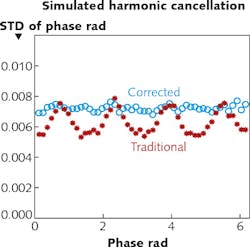Simple modification to ToF lidar data acquisition cancels harmonic error

Homodyne amplitude modulated continuous wave (AMCW) lidar is a camera-based time-of-flight (ToF) distance-measurement technique that captures data at every pixel in a scene. However, systemic errors can be introduced in AMCW ToF by the digital hardware that is involved in acquiring the data. It turns out that the hardware modulating the light source and the sensor can introduce unwanted harmonic content into the signal, distorting it. While various approaches have been devised to combat this problem, they all have their own disadvantages, such as induced random noise or greater complexity. Now, Lee Streeter and Adrian Dorrington of the University of Waikato (Hamilton, New Zealand) have come up with a simple technique to cancel the harmonic error by modifying the data-acquisition procedure. The technique renders the data acquisition invariant to at least one harmonic (with the third harmonic being chosen, as it is the main source of error).
The light source and sensor are modulated at the same rate and with a programmable offset that is changed to measure different distances. Modulating by turning the source and sensor on and off produces square-wave modulation; the frequency content of square-wave modulation consists of the fundamental plus odd-order harmonics, with the third order greatest in amplitude. The change in the four-phase step measurement is based on relaxing the constraint that the phase steps are evenly spaced. The researchers tested their approach via simulation, comparing it to the traditional four-even-phase step AMCW range measurement, and found that it did indeed reject the third harmonic (STD = standard deviation; angles in radians). They note that, with further measurements, higher-order harmonics can also be rejected. Reference: L. Streeter and A. A. Dorrington, Opt. Lett. (2015); http://dx.doi.org/10.1364/OL.40.005391.
About the Author
John Wallace
Senior Technical Editor (1998-2022)
John Wallace was with Laser Focus World for nearly 25 years, retiring in late June 2022. He obtained a bachelor's degree in mechanical engineering and physics at Rutgers University and a master's in optical engineering at the University of Rochester. Before becoming an editor, John worked as an engineer at RCA, Exxon, Eastman Kodak, and GCA Corporation.
